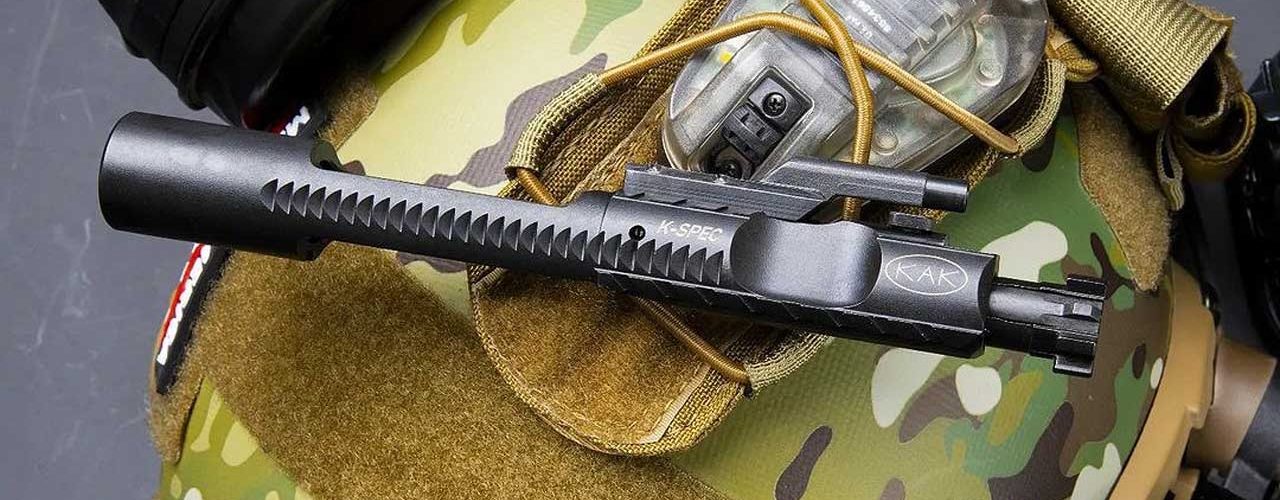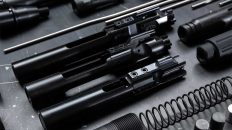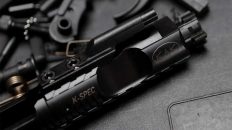If you’re a firearms enthusiast or a beginner looking to understand more about the mechanics of your firearm, having a solid grasp of bolt carrier group (BCG) terminology is essential. The BCG is a crucial component of a semi-automatic or automatic firearm, responsible for facilitating the cycling of rounds, extracting spent casings, and loading new ones.
In this comprehensive glossary, we’ll break down the key terminology surrounding bolt carrier groups, allowing you to navigate the world of firearms with confidence. From terms like gas key and forward assist to cam pin and firing pin, we’ll provide clear definitions and explanations for each term, giving you a deeper understanding of how these components contribute to the overall function and reliability of your firearm.
By the end of this article, you’ll be well-versed in BCG terminology, allowing you to make informed decisions when it comes to upgrading or modifying your firearm. So let’s dive in and unravel the mystery behind bolt carrier groups!
What is a bolt carrier group?
The bolt carrier group (BCG) is a critical assembly within a semi-automatic or automatic firearm that houses several key components responsible for its proper functioning. It is the heart of the firearm’s action, enabling the cycling of rounds and the extraction and ejection of spent casings.
The BCG consists of the bolt, carrier, firing pin, gas key, cam pin, and extractor. Each component plays a vital role in the firearm’s operation, and understanding their functions and terminology is crucial for anyone looking to deepen their knowledge of firearms.
Components of a bolt carrier group
To better understand the terminology surrounding bolt carrier groups, let’s take a closer look at each component and its function within the BCG assembly.
Bolt and its function in a BCG
The AR-15 bolt is the primary component responsible for chambering, extracting, and ejecting rounds in a semi-automatic or automatic firearm. It features locking lugs that engage the barrel extension, ensuring a secure lock-up during firing.
When a round is fired, the expanding gas pushes the bolt rearward, unlocking it from the barrel extension. As the bolt moves rearward, it extracts and ejects the spent casing, and then chambers a new round from the magazine. The bolt is a critical component that must be durable and properly maintained to ensure reliable and safe firearm operation.
The Function of Gas Rings in the BCG
The gas rings play an essential role in the bolt carrier group (BCG), ensuring the proper cycling of a semi-automatic or automatic firearm. Positioned around the bolt, the gas ring s create a seal that allows the high-pressure gas from the fired round to push the bolt carrier rearward, enabling the cycling action. This movement is vital for extracting and ejecting spent casings and chambering new rounds. A worn or damaged gas ring can lead to gas leaks, resulting in failures to cycle and affecting the overall performance of the firearm.
Maintaining the gas rings in the BCG is crucial for reliable firearm operation. Without an effective gas seal, the firearm would struggle to function properly, leading to potential malfunctions and decreased efficiency. Regular inspection and replacement of the gas rings are necessary to keep the firearm performing at its best. By understanding the function of the gas ring and ensuring it is in good condition, firearm owners can ensure their firearms remain dependable and operate smoothly in various conditions.
Extractor and its importance in the BCG
The extractor is a small claw-like component located on the bolt that engages the rim of a chambered cartridge, allowing for its extraction from the chamber. It plays a crucial role in the reliable ejection of spent casings and the chambering of new rounds.
When the bolt moves rearward, the extractor engages the rim of the spent casing, pulling it out of the chamber and ejecting it from the firearm. The extractor must be properly tensioned and maintained to ensure reliable extraction and ejection. Regular cleaning and inspection of the extractor are necessary to remove any dirt or debris that may hinder its proper function.
The Role of the Ejector in the BCG
The ejector is a critical component within the bolt carrier group (BCG) that plays a vital role in the proper functioning of a semi-automatic or automatic firearm. Located on the bolt face, the ejector’s primary function is to expel the spent cartridge casing from the firearm after it has been extracted by the extractor. This ensures that the firearm can continue to cycle rounds smoothly and reliably. A malfunctioning ejector can lead to jams and failures to eject, significantly affecting the firearm’s performance.
The importance of the ejector in the BCG cannot be overstated. Without a properly functioning ejector, the firearm would be unable to clear spent casings, causing interruptions in the firing sequence and potentially rendering the firearm inoperable in critical situations. Regular maintenance and inspection of the ejector are essential to ensure it remains in good working condition. By understanding the role of the ejector and ensuring it is properly maintained, firearm owners can enhance the reliability and longevity of their firearms.
Carrier and its role in the BCG assembly
The bolt carrier is the part of the BCG that houses the bolt and facilitates its movement within the firearm. It is responsible for transferring the energy from the expanding gas to the bolt, allowing the cycling of rounds.
The carrier moves back and forth within the upper receiver, cycling the bolt and facilitating the extraction, ejection, and chambering of rounds. It is essential for the carrier to be properly lubricated to minimize friction and ensure smooth operation. Regular cleaning and maintenance of the carrier are necessary to maintain the overall reliability of the firearm.
Understanding the Cam Pin's Function in the BCG
The cam pin is a critical element within the bolt carrier group (BCG) that plays a significant role in the firearm’s cycling process. It connects the bolt to the carrier and guides the rotational movement of the bolt, allowing it to lock and unlock properly during firing. The cam pin’s precise movement ensures that the bolt engages and disengages with the barrel extension efficiently, which is essential for the extraction and chambering of rounds.
Proper care and maintenance of the cam pin are crucial to ensure the reliable operation of the firearm. Regular inspection for wear and tear and timely replacement can prevent malfunctions and maintain the smooth functioning of the bolt carrier group. By understanding the role of the cam pin and ensuring it is in optimal condition, firearm owners can enhance the overall reliability and performance of their firearms.
Firing pin and its function
The firing pin is a small, cylindrical component within the BCG that strikes the primer of a cartridge, igniting the propellant and firing the round. It is located within the bolt and moves forward when the trigger is pulled, striking the primer with enough force to initiate combustion.
The firing pin must be free to move within the bolt to ensure proper ignition. Regular cleaning and inspection of the firing pin are necessary to remove any debris or fouling that may hinder its movement. A damaged or worn firing pin can result in misfires or failure to ignite the primer, so it is important to replace it if signs of wear or damage are present.
The Role of the Firing Pin Retaining Pin in the BCG
The firing pin retaining pin is a small yet vital part of the bolt carrier group (BCG), responsible for securing the firing pin within the bolt. This pin ensures that the firing pin remains in the correct position, allowing it to strike the primer of a cartridge effectively. If the retaining pin is damaged or missing, the firing pin may become misaligned, leading to misfires or failures to fire, significantly impacting the firearm’s reliability.
Proper maintenance of the firing pin retaining pin is essential for the smooth operation of a firearm. Regular inspection and replacement, when necessary, can prevent potential malfunctions. By understanding the importance of this component and keeping it in good condition, firearm owners can maintain the dependability and functionality of their firearms, ensuring they perform reliably in various situations.
Gas key and its importance
The gas key is a small, rectangular piece of metal located on top of the bolt carrier. It serves as a connection point for the gas tube, allowing the high-pressure gas generated by the fired round to enter the BCG and cycle the action.
The gas key is crucial for the reliable operation of the firearm. It must be properly staked to prevent it from coming loose during firing. If the gas key becomes loose or misaligned, it can lead to gas leakage, resulting in failures to cycle or extract rounds. Regular inspection and maintenance of the gas key are essential to ensure the proper functioning of your firearm.
Conclusion and final thoughts
Understanding the key terminology surrounding bolt carrier groups is essential for anyone looking to deepen their knowledge of firearms. Each component within the bolt carrier group plays a crucial role in the reliable functioning of the firearm, and being familiar with their functions and terminology allows for informed decision-making when it comes to upgrading or modifying your firearm.
From the gas key and bolt to the carrier, firing pin, and extractor, each component has a specific role and requires regular maintenance to ensure optimal performance. By taking the time to understand the terminology and functions of the bolt carrier group, you’ll have a deeper appreciation for the mechanics of your firearm and the confidence to make informed choices when it comes to its maintenance and improvement.
So, next time you handle your firearm, take a moment to examine the bolt carrier group and appreciate the intricate interplay of its components. With this comprehensive glossary as your guide, you’ll be well-equipped to navigate the world of firearms with confidence and knowledge. Stay safe and happy shooting!





Add comment